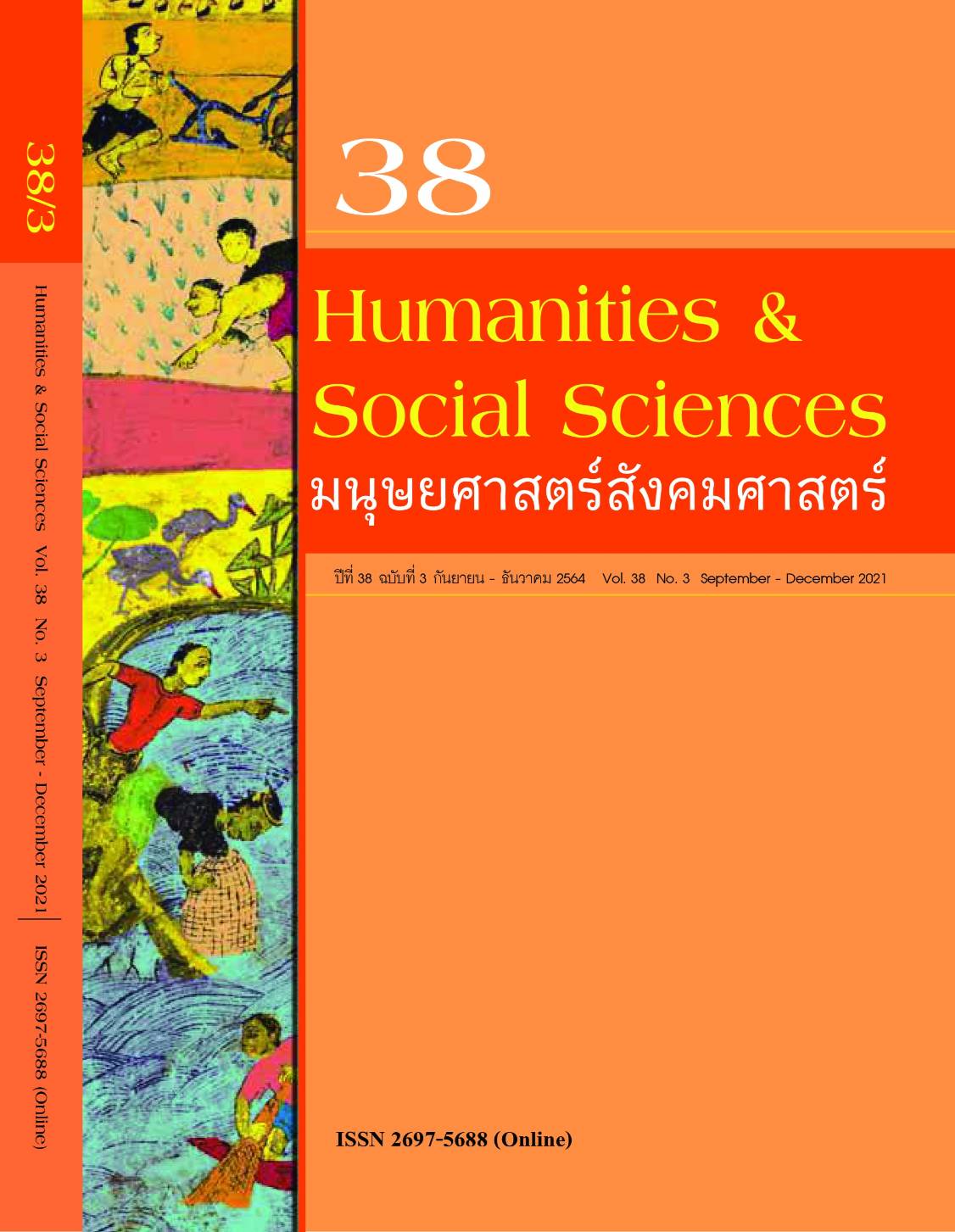ผลกระทบของการเปลี่ยนแปลงสภาพภูมิอากาศและการปรับตัวของประชากรตามมิติทางเพศและสังคม: กรณีศึกษาชุมชนเม็กดำ จังหวัดมหาสารคาม
Gender and Social Dimensions of Climate Change Impact and Adaptation: A Case Study of Mekdum Community, Maha Sarakham Province
คำสำคัญ:
การเปลี่ยนแปลงสภาพภูมิอากาศ, มิติชายหญิง, มหาสารคามบทคัดย่อ
การเปลี่ยนแปลงสภาพภูมิอากาศไม่ได้ส่งผลกระทบต่อการประกอบอาชีพเกษตรกรรมเท่านั้น แต่ยังส่งผลกระทบต่อสถานภาพทางเศรษฐกิจสังคมและวิถีชีวิตความเป็นอยู่ของประชากร ซึ่งการรวบรวมและวิเคราะห์ข้อมูลผลกระทบของการเปลี่ยนแปลงสภาพภูมิอากาศจำแนกตามมิติด้านเพศและสังคมเป็นสิ่งสำคัญมากต่อความสำเร็จในการกำหนดนโยบายการพัฒนาเชิงพื้นที่ ดังนั้น การศึกษาในครั้งนี้จะมีวัตถุประสงค์เพื่อวิเคราะห์ผลกระทบของการเปลี่ยนแปลงสภาพภูมิอากาศต่อกลุ่มของประชากรในชุมชนที่แตกต่างกันทั้งในมิติทางเพศและสังคม รวมทั้งวิเคราะห์แนวทางการรับมือและการปรับตัวของกลุ่มประชากรในชุมชน โดยพื้นที่ศึกษาคือชุมชนเม็กดำ จังหวัดมหาสารคาม ซึ่งเป็นชุมชนที่ได้รับผลกระทบจากการเปลี่ยนแปลงสภาพภูมิอากาศทั้งน้ำท่วมและภัยแล้ง ใช้ระเบียบวิธีวิจัยเชิงคุณภาพตามแนวทางการวิเคราะห์สถานการณ์และการวิเคราะห์มิติทางเพศและสังคม
ผลการศึกษาพบว่า ปัญหาหลักที่สำคัญจากการเปลี่ยนแปลงสภาพภูมิอากาศในชุมชนเม็กดำคือปัญหาภัยแล้ง จากการประเมินขีดความสามารถของกลุ่มประชากรในการตอบสนองต่อปัญหาการเปลี่ยนแปลงสภาพภูมิอากาศพบว่า เพศไม่มีผลต่อความสามารถของครัวเรือนในการรับมือกับผลกระทบของการเปลี่ยนแปลงสภาพภูมิอากาศ ในขณะที่อายุและฐานะทางเศรษฐกิจเป็นปัจจัยสำคัญที่ส่งผลต่อความสามารถในการรับมือกับปัญหาภัยแล้ง กล่าวคือกลุ่มประชากรวัยทำงานและครัวเรือนที่มีสถานะทางเศรษฐกิจสูงขึ้นสามารถปรับตัวรับมือกับผลกระทบจากภัยแล้งได้ดีขึ้น ดังนั้น เพื่อลดผลกระทบจากภัยแล้งโครงการชุมชนที่สำคัญที่สุดคือการสร้างฝายชะลอน้ำและการจัดหาระบบสูบน้ำด้วยพลังงานแสงอาทิตย์ รองลงมาเป็นการขุดลอกลำน้ำธรรมชาติด้านให้สามารถกักเก็บน้ำได้มากขึ้น
References
MonetPolicyComittee/MPR/BOX_MPR/BOXMPR_TH_Jun2562-01.pdf
พรพรรณ สอนเชื้อ. (2560). การเปลี่ยนแปลงภูมิอากาศกับโรคติดเชื้อ. ธรรมศาสตร์เวชสาร. 17(3): 440-447.
สำนักงานคณะกรรมการพัฒนาการเศรษฐกิจและสังคมแห่งชาติ. (2562). ผลิตภัณฑ์มวลรวมจังหวัด. สืบค้นวันที่ 16 กันยายน 2563, จาก https://www.nesdc.go.th/ewt_dl_link.php?nid=5628&filename=gross_regional
สำนักนโยบายและแผนทรัพยากรธรรมชาติและสิ่งแวดล้อม. (2558). แผนแม่บทรองรับการเปลี่ยนแปลงสภาพภูมิอากาศ พ.ศ. 2558-2593. สืบค้นวันที่ 16 กันยายน 2563, จาก http://www.onep.go.th/book/แผนแม่บทรองรับการเปลี่ยนแปลงสภาพภูมิอากาศ/
ศศิวุฑฒิ์ วงษ์มณฑา. (2560). รายงานฉบับสมบูรณ์โครงการ การวิเคราะห์ความเปราะบางของครัวเรือนต่อการเปลี่ยนแปลงเศรษฐกิจไทย. สำนักงานกองทุนสนับสนุนการวิจัย (สกว.).
Barnaud, B.M. and N. Suphanchaimart. (2006). Rural Poverty and Diversification of Farming Systems in Upper Northeast Thailand. Agriculture in Southeast Asia: an update. DOI: http//www.10.4000/moussons.
Boonto, P. (2008). Woman’s Decision – Making Power in the Rural Family in Northeastern Thailand. A Dissertation of Doctor of Philosophy (Population and Development) School of Applied Statistics National Institute of Development Administration. Retrieved from http://libdcms.nida.ac.th/thesis3/2008/b158097.pdf
Felkner, J., K. Tazhibayeva and R. Townsend. (2019). Impact of climate change on rice production in Thailand. American Economic Review. 99(2): 205–210.
Mahaarcha, W. (2019). Factor influencing farmers’ Adaptation strategies to climate change in Bophloi District, Kanchanaburi province, Thailand. Humanities, Art and Social Sciences Studies. 19(1): 70-86.
Maskrey, A., Buescher, G., Peduzzi, P., and C. Schaerpf. (2007). Disaster risk reduction: 2007 global review. Consultation Edition Prepared for the Global Platform for Disaster Risk Reduction First session, Geneva, Switzerland 5 - 7 June 2007. Retrieved from https://www.preventionweb.net/globalplatform/2007/first-session/docs/session_docs/ISDR_GP_2007_3.pdf
Pasukphun, N. (2019). Preliminary Evaluating Environmental Health Effect of Climate Change towards Community Adaptation Framework: A Case Study of Maha Sarakham Province, Thailand. PSRU Journal of Science and Technology. 4(1): 1-18.
Petprasert, N., Y. Siriporn, S. and V. Setthakrit. (1998). The Status of the Poor in the Economic Crisis. In The Thai Poor in the Crisis, edited by N. Petprasert, pp. 198–228. Bangkok: Edison Press Products Company.
Polthanee, A., Promkumbut, A., and Bamrungrai, J. (2014). Drought Impact on Rice Production and Farmers’ Adaptation Strategies in Northeast Thailand. International Journal of Environmental and Rural Development. 5-1: 45-52.
Prapertchop, P., Bhandari, H., and Pandey, S. (2007). Economic Cost of Drought and Rice Farmers’ Coping Mechanism in Northeast Thailand. In: Economic Cost of Drought and Rice Farmers’ Coping Mechanisms: A Cross Country Comparative Analysis. Pandey, S., Bhandari, H., Hardy, B. (eds). International Rice Research Institute, Los Banos, Philippines, 116-148.
Prabnakorn, S., M. Shreedhar, F.X. Suryadi, and C.D. Fraiture. (2018). Rice Yield in Response to Climate Trends and Drought Index in the Mun River 2 Basin, Thailand. Science of the Total Environment. 621: 108-119. doi: 10.1016/j.scitotenv.2017.11.136.
Prabnakorn, S., Maskey, S., and F.X. Suryadi. (2019). Assessment of drought hazard, exposure, vulnerability, and risk for rice cultivation in the Mun River Basin in Thailand. Natural Hazards. 97: 891–911. https://doi.org/10.1007/s11069-019-03681-6
Suriyasarn, B. and Talerngsri, B. (2020). Social Dimension of Climate Change Impacts in Thailand: Analysis of Risks, Policy, Planning and Finance. UNDP Thailand NDC Support Project.
World Bank. 2009. South Asia: Shared Views on Development and Climate Change. Retrieved from http://documents.worldbank.org/curated/en/789001468294334973/
pdf/520510WP0SAR1C10Box345549B01PUBLIC1.pdf


